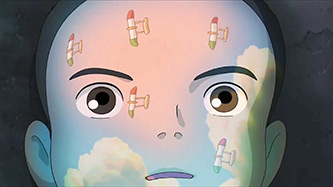Studio Ghibli's offerings are usually a pretty solid bet for me, Takeshi. They always have just the right amount of newness, weirdness, and cuteness for me to kill a couple of hours without dwelling on the film for very long after. And if nothing else, I can sit back and enjoy the pretty colours. However, The Wind Rises had me dwelling. It had me dwelling for quite a while.
You helped Hayao Miyazaki's cut together elements of history, romance, nostalgia, and fantasy on one of his undeniably gorgeous canvases, but they all jostle for attention in a film that doesn't seem to know what kind of story it wants to tell.
The story it does tell - the fanciful biography of WWII-era aircraft engineer Jiro Horikoshi, a boy with his head in the clouds who went on to design fighter planes for the Japanese military - spans about twenty years. You carry us through the timeline with a pace that matches the wind.
And the wind - as one might imagine from the title - features prominently. From scenes of widespread devastation to the quiet, intimate moments between Jiro and his wife, the Wind asserts its presence, roaring through an airplane engine or gently disturbing a lock of hair. Like every one of your cuts, it leads the audience from one scene to the next. While this keeps the action from lagging, it's also a bit too hurried. As the film floats between real-life and dream sequences, the narrative could have done with a more forgiving pace; there are scenes and moments that really deserve a pause, time for the audience to fully absorb the emotional impact. Even the moment when Jiro reflects upon the use of his planes as instruments of war has not time to settle before the Wind rolls through in a balletic, pastel swirl, and you cut away to the next scene.
Another unfortunate consequence of this too-swift pacing is that it's difficult to know where to focus. The love story, while sweet, is unsatisfying. And the historical elements are hard to fully appreciate because, in trying to fit them in alongside the romance and the dream sequences, you have to truncate major events like The Great Kanto Earthquake and the Pacific war. Which is a let-down, since Jiro's dream of designing beautiful planes being co-opted by the Japanese war machine is perhaps the most compelling part of the story.
While I would have preferred that you and Miyazaki lingered on some of the more poignant moments in the film, I was happy enough to relinquish control to the wind. And to you. It was, if nothing else, beautiful to watch.
Floating off,
Nat.







